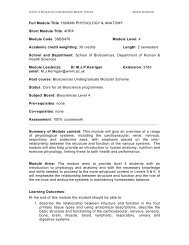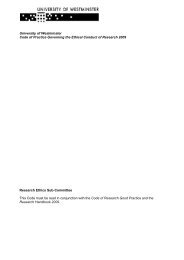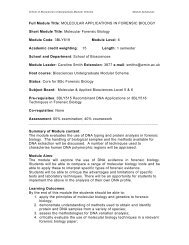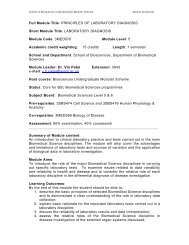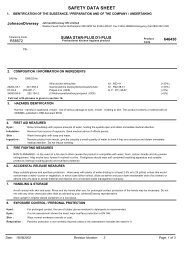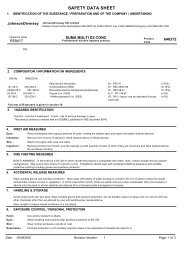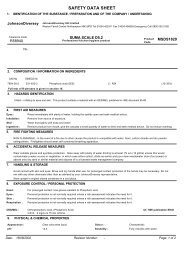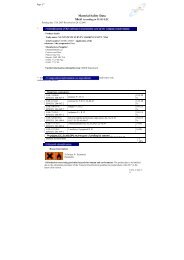CONTENTS 1. Introduction 1.1 Course Outline 1 1.2 Introduction ...
CONTENTS 1. Introduction 1.1 Course Outline 1 1.2 Introduction ...
CONTENTS 1. Introduction 1.1 Course Outline 1 1.2 Introduction ...
Create successful ePaper yourself
Turn your PDF publications into a flip-book with our unique Google optimized e-Paper software.
Full Module Title:<br />
ADVANCED PHOTOSCIENCE<br />
Module Code: 2DPI511 Module Level: 5<br />
Academic credit weighting: 30 credits. Length: 2 semesters<br />
School:<br />
Media, Art and Design.<br />
Department:<br />
Photographic and Digital Media<br />
Module Leader: Sophie Triantaphillidou Extension: 4584<br />
Host <strong>Course</strong>:<br />
BSc(Hons) Photography and Digital Imaging<br />
Status:<br />
Core.<br />
Subject Board:<br />
Pre-requisites:<br />
None.<br />
Co-requisites:<br />
None.<br />
Assessment:<br />
40% laboratory work<br />
20% written coursework<br />
40% examination.<br />
Summary of Module content:<br />
Light and radiation. Applicable solid-state physics for light and radiation generation and<br />
detection. Image formation. <strong>Introduction</strong> to Fourier imaging and information theory. Sampling<br />
and aliasing. Supporting mathematics including calculus, the Fourier transform, complex variable<br />
theory, introductory matrix algebra. Statistics of analysis of variance.<br />
Module Aims:<br />
• To extend the scientific study of imaging systems and images.<br />
• To develop methods of quantifying and measuring image quality and imaging performance.<br />
• To introduce and develop important mathematical techniques.<br />
Learning Outcomes:<br />
On completion of the module the successful student will be able to:<br />
<strong>1.</strong> Handle the essential mathematical tools necessary for the analysis of the imaging chain<br />
as a communications channel.<br />
2. Describe the role of Fourier theory in linear image formation.<br />
3. Implement the main Fourier–based methods of image analysis.<br />
4. Describe the principles of light production and detection and summarise some of the<br />
advanced aspects of the physics of image formation in digital and photographic systems.<br />
5. Devise and carry out appropriate experiments to compare the imaging performance of<br />
different systems.<br />
Indicative syllabus content:<br />
Electromagnetic radiation. Production of light. Solid State Physics. Quantum nature of light and<br />
light and radiation detection. <strong>Introduction</strong> to Fourier Imaging. Linear stationary systems.<br />
Convolution. Sampling and the sampling theorem. Aliasing and aliasing artifacts.<br />
Image noise analysis. Information and efficiency. Detective Quantum Efficiency and its<br />
application to general imaging systems.<br />
Integration, numerical integration, the meaning of convolution and autocorrelation. Complex<br />
numbers and phase. Matrix algebra and matrix inversion. Vectors: Addition, scalar and vector<br />
products. Statistics: analysis of variance.<br />
Teaching and Learning Methods:<br />
Illustrated lectures and workshops (appx 36 hrs). Laboratory work (appx 24 hrs). Seminars and<br />
tutorials (appx 12 hrs).<br />
Assessment Rationale:<br />
DPI_Hbook 56 ©University of Westminster





